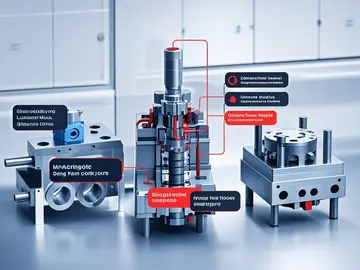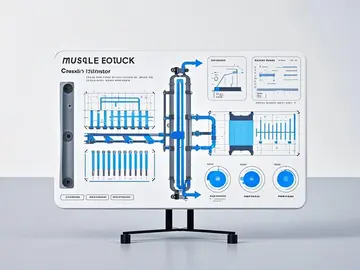
Runnerless vs. Runner Injection Molding: Which Offers Better Cost Efficiency?
Injection molding is a cornerstone of modern manufacturing, but the choice between runnerless (hot runner) และ traditional runner (cold runner) systems can significantly impact production costs and efficiency. This article breaks down the differences, cost implications, and ideal use cases for both technologies.
Understanding Injection Mold Cavity Types
Injection mold design is key to making manufacturing better and more precise. There are two main types of cavities: single-cavity and multi-cavity molds. Each has its own uses and benefits.
Designing an injection mold requires thinking about many things. These include the material, the product’s shape and size, and the manufacturing process. The choice of cavity type depends on the production needs, like how many parts are needed and how complex they are.
Choosing the right cavity type can make manufacturing better. Single-cavity molds are good for small batches or complex parts. Multi-cavity molds are best for making lots of the same part quickly and efficiently.
Here are some main differences between single-cavity and multi-cavity molds:
- Production volume: Single-cavity molds are for small batches, while multi-cavity molds are for big ones.
- Product complexity: Single-cavity molds are for complex parts, and multi-cavity molds for simpler ones.
- Manufacturing process: Single-cavity molds are for precise processes like overmolding, while multi-cavity molds are for fast production.
Knowing about cavity types helps manufacturers improve their mold design and processes. This leads to better efficiency, quality, and productivity.
The Cost Factor: Initial Investment and Long-term Returns
When choosing injection mold cavity types, cost is a big deal. The price of a mold affects production costs และ return on investment. It’s important for manufacturers to think about the cost savings of each mold type.
The cost of the mold itself varies a lot. Cost savings can come from using a multi-cavity mold. It makes more parts at once, cutting down on production costs per item. But, a multi-cavity mold costs more upfront than a single-cavity one.
Looking at cost savings และ return on investment has its perks:
- Lower production costs per item
- More efficiency and productivity
- Better return on investment over time
By weighing the costs and thinking about cost savings และ return on investment, manufacturers can pick the right mold for their needs.
Core Differences Between Runnerless and Runner Molding
- Runnerless (Hot Runner) Systems:
- No Solidified Runner Waste: Melted plastic stays in heated manifolds, eliminating the need to discard cold runners.
- Higher Initial Cost: Complex temperature-controlled systems increase upfront investment.
- Faster Cycle Times: Reduced cooling requirements speed up production.
- Traditional Runner (Cold Runner) Systems:
- Material Waste: Runners solidify and must be trimmed/recycled, wasting 10-30% of raw material.
- Lower Tooling Costs: Simpler design reduces initial setup expenses.
- Slower Cycles: Cooling time for runners extends production timelines.
Multi-Cavity vs. Single-Cavity Injection Molds: A Technical Breakdown
When we talk about injection molding, comparing multi-cavity and single-cavity molds is key. Multi-cavity molds are more complex, needing detailed tooling and engineering. This makes them more expensive upfront. Single-cavity molds, however, are simpler and cost less at the start.
Maintenance is another important factor. Multi-cavity molds need more upkeep because of their complexity. This can add up in costs over time. Single-cavity molds, with fewer parts, require less maintenance and are cheaper to keep running. Knowing these differences helps in making a smart choice.
ข้อควรพิจารณาที่สำคัญ
- Design complexity: Multi-cavity molds have a more complex design, while single-cavity molds have a simpler design.
- Maintenance requirements: Multi-cavity molds require more frequent maintenance, while single-cavity molds have lower maintenance requirements.
- Operational challenges: Multi-cavity molds can be more challenging to operate due to the increased complexity, while single-cavity molds are generally easier to operate.
In conclusion, comparing multi-cavity and single-cavity injection molds is crucial for production needs. By looking at design complexity, maintenance, and operation, manufacturers can choose wisely. This helps in optimizing their production processes.
Selecting the Right Mold for Your Manufacturing Needs
Choosing the right mold is crucial for manufacturers. They need to think about their manufacturing needs และ production goals. They must consider the product type, how much they plan to make, and the quality they aim for.
Design complexity is another important factor. For complex designs, a more advanced mold might be needed. Working with a trusted mold maker can help find the best mold for your production goals. They offer:
- Expert advice on mold selection and design
- Access to the latest manufacturing tech and materials
- Better quality control and fewer mistakes
The right mold choice can greatly help manufacturers reach their production goals. By carefully looking at their manufacturing needs and getting expert help, they can improve their production. This keeps them competitive in the market.
Cost Efficiency Breakdown
| Factor | Runnerless Molding | Runner Molding |
|---|---|---|
| Material Waste | 0-5% waste | 10-30% waste |
| Energy Consumption | Higher (heating maintenance) | Lower |
| Cycle Time | 15-30% faster | Slower due to runner cooling |
| Tooling Cost | $20,000-$100,000+ | $5,000-$30,000 |
| Long-Term Savings | High-volume savings | Better for small batches |
Choosing the Right System: Runner vs. Runnerless
When to Choose Runnerless Molding
- Ideal for high-volume production (100,000+ หน่วย).
- Best for expensive materials (e.g., medical-grade polymers).
- Supports sustainability goals by minimizing waste.
When to Choose Runner Systems
- Suitable for low-to-medium batch production.
- Lower upfront costs make it budget-friendly.
- Offers simplicity and flexibility, ideal for prototyping.
Conclusion: Making the Strategic Choice for Your Production Goals
The choice between a multi-cavity or single-cavity injection mold greatly affects your efficiency และ production goals. By considering the factors in this article, you can make a smart choice. This choice should match your specific needs and goals.
Whether you focus on cost-effectiveness, production volume, or quality control, the right mold type matters. It can improve your profitability and help you deliver top-quality products to your customers.
There’s no single best choice for injection molding. While runnerless injection molding offers long-term cost efficiency for large-scale production, traditional runner systems remain a practical choice for smaller operations. Evaluate your production scale, material costs, and sustainability goals to determine the best fit.
Cost-Benefit Analysis: XLD’s Data-Driven Approach
At XLD Mould, we provide transparent ROI projections to help you choose the best system for your needs.
Hot Runner Advantages
- Material Recovery: 95-100% vs. 70% with cold runners.
- Faster Cycles: 15-25% reduction in cycle time for mass production.
Cold Runner Flexibility
- Lower Tooling Costs: Starting at $8,000 for small batches.
- Best for: Short-run orders under 10,000 หน่วย.
Why Partner with XLD Mould?
✔ 12+ Years of Expertise – ISO-certified designs meeting FDA, ยานยนต์, and aerospace standards.
✔ End-to-End Service – From mold flow analysis to post-production support.
✔ Global Trust – Serving clients across Europe, North America, and Asia.
🔍 Explore Our Success Stories: xld-mould.com/case-studies
Take Action
🔹 Need a cost-efficient runner system? Request a Quote
📘 Get Expert Insights: Download “10 Tips to Cut Injection Molding Costs by 20%”


The injection molding process is complex and creates plastic products. Dark spots are a common issue that affects these products